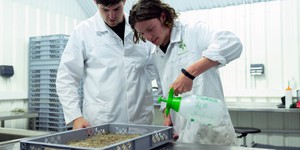Abstract
Take a deep breath: freshly baked cookies, smoke from a wood fire, or a rose—your nose is an amazing smell detector! Your sense of smell can not only identify a huge variety of odors, but it is also incredibly sensitive. Think about how easily you can detect if someone in your neighborhood has a barbecue just by smelling the hints of smoke from the grill far away. How strong or weak you perceive an odor depends on its concentration. What do you think is the lowest concentration of a specific scent that one can still smell? Will it depend on which scent you choose? In this science project, you will determine and compare the odor threshold—the lowest concentration you and your volunteers can smell—for different odors.Summary
This project requires the participation of volunteers. Make sure you are familiar with your science fair's rules about tests involving human volunteers before you start. For suggestions and common rules check out the Science Buddies resource Projects Involving Human Subjects.
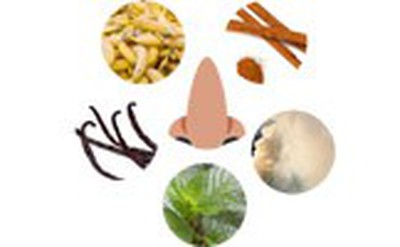
Objective
Determine and compare the odor threshold—the lowest concentration you or your volunteers can smell—for different scents.
Introduction
Every day we are surrounded by a vast number of different smells and our nose is able to pick up a huge variety of them. Just close your eyes, and take a deep breath; can you make out specific scents in the air—maybe the electronic smell of your computer or the hand lotion on your hands? Your sense of smell, also called olfaction, is very powerful. Smell can even trigger memories. For instance, does the smell of gingerbread make you remember the last holiday season? Did you know that we also communicate via smell? Researchers have found that we judge other people depending on their body odor: Do I like this person, is he or she attractive or trustworthy? Your nose definitely has a say in that, too.
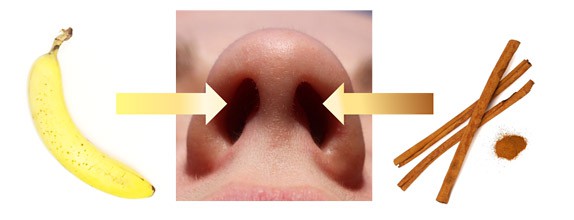 Image Credit: Svenja Lohner, Science Buddies, Wikimedia Commons users Kuebi, Lviatour / Creative Commons Attribution-Share Alike License
Image Credit: Svenja Lohner, Science Buddies, Wikimedia Commons users Kuebi, Lviatour / Creative Commons Attribution-Share Alike License
Figure 1. Our nose is an amazing smell detector that can sense many different odors. (Image credit for nose and cinnamon sticks: Wikimedia commons)
Your nose is also where smelling starts, but have you ever wondered how it can detect smells? Let us get nosy and find out how it works. Many parts deep inside your nose and your brain work together to help you figure out what you are smelling. Everything that has an odor or smell, releases specific chemicals into the air, called odorants. These odorants eventually reach your nose and when breathing in, they get transported all the way up deep into the space behind your nose. There you have millions of smell receptors that are able to identify specific odorants. You can imagine this process like a key-and-lock mechanism, where each odor molecule fits into one specific receptor inside your nose. Once the receptor binds to the chemical, it communicates with the brain by sending a signal and your brain is able to identify the specific odor.
But what makes one smell different from another? The answer to this is that hundreds and thousands of different chemicals exist that trigger the sensation of smell, and each individual one—as well as multiple combinations between them—will result in a different smell and a different signal pattern in your brain. Researchers now believe that we can smell up to 1 trillion (this is more than 100 times as many people there are in the world) different scents, meaning individual odorants, as well as mixtures! Sometimes only one single chemical is characteristic for one specific smell and many people, especially in the food industry, try to produce them to make artificial scents. One example is a chemical molecule called vanillin, which, as you might guess, smells like vanilla.
But how do we analyze and measure smell, and is this even important? It is, especially for people who create perfumes or foods with different scents, and also because not every smell is pleasant. You might have complained about a nasty smell before. This is why specific methods exist to measure how much of a certain odor is in the air and, more importantly, how much of it people can smell and tolerate. The odor intensity, or how strong or weak you perceive a smell, is dependent on how much of the smell-causing chemical is in the air, also called its concentration. You might have experienced this, for example, when you came home and walked toward the kitchen and the smell of freshly baked cookies was in the air. However, when you got into your room, the smell was much less intense, or not even detectable at all. This is because there needs to be a certain amount of odorant in the air—the so-called odor threshold concentration—before smell receptors can send enough signals to the brain to identify a specific odorant. What makes the odor threshold for each odorant different is their different chemical properties, such as molecule shape, partial charges, polarity, or molecular mass. However, until now the exact olfactory mechanism explaining the difference in odor thresholds is not well understood.
This is why researchers need the help of a smell panel, or volunteers, to do extensive smell tests in a laboratory in order to determine odor thresholds for specific odors. Such smell tests are based on the dilution of an odor sample to the point at which the odor is only just detectable to half of the volunteers. The numerical value of this odor threshold concentration is equal to the dilution factor that is necessary to reach the odor threshold. In this science project, you will perform such a smell experiment yourself. Gather a group of volunteers, pick a variety of smells, and find out what the odor threshold is for each of them! Do you think they will be different for each scent?
Terms and Concepts
- Sense of smell
- Olfaction
- Odor
- Chemical
- Odorant
- Smell receptor
- Artificial scent
- Odor intensity
- Concentration
- Odor threshold
- Dilution
- Dilution factor
Questions
- Why is the sense of smell so important?
- How does your nose recognize a specific smell and why can we smell so many different scents?
- What is the odor threshold and how can it be determined?
- Do you think different odors have different odor thresholds? If yes, why is that so?
- How can the knowledge about odor thresholds be useful in the real world? Think about artificial scents in the food industry or odor complaints at a wastewater treatment plant.
Bibliography
Here you can find more information about how the nose works and detects smells:
- KidsHealth. Your nose. Retrieved November 12, 2015.
- Smithsonian. (2014). The human nose can distinguish between one trillion different smells. Retrieved November 12, 2015.
- Eveleth, R. (2013). How do we smell? TedEd Lessons Worth Sharing. Retrieved November 12, 2015.
- Time. (2014). Your nose can smell at least 1 trillion scents. Retrieved March 11, 2016.
To learn more about scents and smells, use these resources:
- Science in School. (2007). Small molecules make scents. Retrieved November 12, 2015.
- Flavornet. Flavor lexicon. Retrieved November 2015.
Materials and Equipment
- Molecule-R Aroma E-evolution kit, available from Amazon.com
- Plastic cups, 7 oz (5)
- Medicine dropper (1)
- Distilled water (1 L)
- Mini plastic cups with lids, 2 oz (at least 30), available from Amazon.com.
- Disposable syringe, 10 mL (1), available from Amazon.com.
- Graduated cylinder, 100 mL (1), available from Amazon.com.
- Spoons (5)
- Permanent marker
- A "smell panel" of 8–10 volunteers (Note: To see how many volunteer subjects you need, check out the Science Buddies resource Sample Size: How Many Survey Participants Do I Need?)
- Masking tape
- Highlighter
- Lab notebook
Disclaimer: Science Buddies participates in affiliate programs with Home Science Tools, Amazon.com, Carolina Biological, and Jameco Electronics. Proceeds from the affiliate programs help support Science Buddies, a 501(c)(3) public charity, and keep our resources free for everyone. Our top priority is student learning. If you have any comments (positive or negative) related to purchases you've made for science projects from recommendations on our site, please let us know. Write to us at scibuddy@sciencebuddies.org.
Experimental Procedure
Working with Human Test Subjects
There are special considerations when designing an experiment involving human subjects. Fairs affiliated with Regeneron International Science and Engineering Fair (ISEF) often require an Informed Consent Form (permission sheet) for every participant who is questioned. Consult the rules and regulations of the science fair that you are entering, prior to performing experiments or surveys. Please refer to the Science Buddies documents Projects Involving Human Subjects and Scientific Review Committee for additional important requirements. If you are working with minors, you must get advance permission from the children's parents or guardians (and teachers if you are performing the test while they are in school) to make sure that it is all right for the children to participate in the science fair project. Here are suggested guidelines for obtaining permission for working with minors:
- Write a clear description of your science fair project, what you are studying, and what you hope to learn. Include how the child will be tested. Include a paragraph where you get a parent's or guardian's and/or teacher's signature.
- Print out as many copies as you need for each child you will be surveying.
- Pass out the permission sheet to the children or to the teachers of the children to give to the parents. You must have permission for all the children in order to be able to use them as test subjects.
The Molecule-R Aroma E-evolution kit comes with 21 different scents, but for this experiment you will use only five of them: one fruit scent (banana), one herb scent (mint), one spice scent (cinnamon), one bean scent (vanilla), and one savory scent (smoke). All of the smells in the aroma kit should have approximately the same concentration, which is the amount of odorant per volume of liquid. For the smell test, you will make odor samples with lower concentrations by diluting the concentrated scents in distilled water. The dilution factor (see the Technical Note) at which half of your volunteers can just detect the odor correctly will be equal to its odor threshold concentration.
For the smell test, you have to prepare a serial dilution of your concentrated scents. A serial dilution is a method for accurately diluting a solution in regular steps. You add a known amount of your original sample that you are going to dilute, also called stock solution, to a known amount of water and mix them. The new concentration will be determined by the ratio of the volume of stock solution to the new sample volume, as shown in Equation 1.
Equation 1:Where
If the volume of stock solution and the volume of water are equal, you will be diluting the solution by half. This is called a two-fold dilution. If you want more than a two-fold dilution, you should use relatively more water; if you want a less diluted solution, you should use relatively less water. By repeating the process, you can make a whole series of dilutions, which is how the method got its name.
You can calculate the dilution factor for each dilution according to Equation 2. In a series of subsequent dilutions, the dilution factors are multiplied; for instance, if you dilute a stock dilution two times by two-fold, the first dilution will have a dilution factor of 2 and the second solution will have a dilution factor of 4 (2 times 2).
Equation 2:Where
and refers to the solution that you are diluting
Before you start with the smell test, you will generate a stock solution for each smell by putting one drop of concentrated scent solution in 100 mL of water. As one drop corresponds to about 0.05 mL of concentrated scent solution, the dilution factor of this stock solution will be approximately 2,000 (volume(new sample) is 100.05 mL and volume(stock) is 0.05 mL). From this stock solution, you will generate a series of two-fold dilutions, which means that your dilution factor will double for each sample dilution that you prepare (see Table 1).
| Dilution level (cup number) | 0 (water) | 1 | 2 | 3 | 4 | 5 | 6 |
|---|---|---|---|---|---|---|---|
| Stock solution | solution 2 | solution 3 | solution 4 | solution 5 | solution 6 | concentrated scent | |
| Volume stock (mL) | 0 | 5 | 5 | 5 | 5 | 5 | 0.05 |
| Volume new sample (mL) | 10 | 10 | 10 | 10 | 10 | 10 | 100 |
| Dilution factor | Blank | 64,000 | 32,000 | 16,000 | 8,000 | 4,000 | 2,000 |
Preparing the Smell Samples
When preparing the smell samples, make sure that you do not wear any perfume or have lotion on your hands, otherwise your volunteers will end up smelling your perfume or hand lotion instead of the actual scent. Also note, that you should do the smell test within 1–2 days of preparing your test solutions. If it takes longer than that, you should prepare fresh solutions for the test.
- Pick all five scents that you will use in this experiment: banana, vanilla, cinnamon, mint, and smoke, as shown in Figure 2.
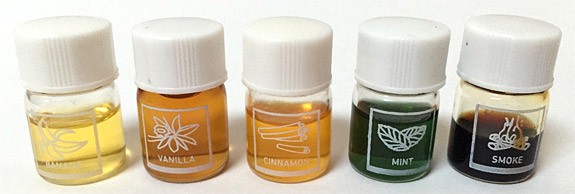 Image Credit: Molecule-R Aroma E-volution kit / Moleculer Recipes
Image Credit: Molecule-R Aroma E-volution kit / Moleculer Recipes
Figure 2. Concentrated scent solutions from the Molecule-R Aroma E-evolution kit.
- Take five 7 oz plastic cups and, with a permanent marker, label each of them with a different scent (banana, vanilla, cinnamon, mint, and smoke).
- Fill each plastic cup with 100 mL of distilled water. Use the 100 mL graduated cylinder for measuring out 100 mL of the distilled water.
- To make your first stock solution, choose one scent and use the medicine dropper to take out some of the concentrated liquid from its vial. Put one single drop of the liquid into the respective cup filled with 100 mL distilled water. Make sure you put the liquid in the correctly labeled cup. You will use this stock solution to make lower concentrated odor samples (see the Technical Note).
- Repeat this for all the other scents. Remember to rinse your medicine dropper before you switch to a new vial.
- Take a spoon and stir the water-scent stock solutions well. Use a different spoon for each cup.
- For each scent, label seven 2 oz mini cups with a letter representing the odorant and a number from 0–6.
- Make up a letter code for the different scents so your volunteers will not know what is inside the cups. You could use "a" for banana, "b" for mint, "c" for cinnamon, "d" for vanilla and "e" for smoke. For example, your banana mini cups could be labeled a0, a1, a2, a3, a4, a5 and a6. Note what letters you used for which scent in your lab notebook.
- Write the code on the mini cups with permanent marker.
- Create a two-fold dilution series for one particular scent.
- Select all mini cups labeled with the letter corresponding to the selected scent.
- With the 10 mL syringe, fill all mini cups labeled 0–5 with 5 mL distilled water. Do not fill cup number 6.
- Pick the stock solution for the selected scent. Take the 10 mL syringe and fill it with 10 mL stock solution that you prepared for this scent.
- Put 5 mL of the stock solution in empty mini cup 6.
- Put the remaining 5 mL stock solution in the cup labeled 5 that has 5 mL distilled water in it. Swirl the mini cup so this new solution is well mixed. This will be the stock solution for your next dilution level.
- Rinse the syringe with distilled water and use the rinsed syringe to take 5 mL out of your new stock solution for the next dilution level.
- Put the 5 mL of your new stock solution into the next mini cup (4, 3, 2, or 1, not mini cup 0). Swirl to mix well.
- Repeat steps f. and g. for all mini cups, always using your new generated solution as stock solution for the next dilution level. Make sure to rinse the syringe and mix solutions well in between each dilution step.
- When you are finished with mini cup 1, take 5 mL solution from mini cup 1 and discard it in the sink , so that each cup contains 5 mL scent solution.
- Note that you did not add any scent to mini cup 0. This one will be your control that you compare your samples with, or blank with no smell, and contains only distilled water.
- All mini cups (except cup 0) now contain 5 mL solution of one scent, with cup 6 containing the highest concentration and cup 1 having the lowest concentration (Figure 3). The Technical Note lists the dilution factors for each cup and explains how they are calculated.
- Put lids on each of the mini cups so the odor stays inside.
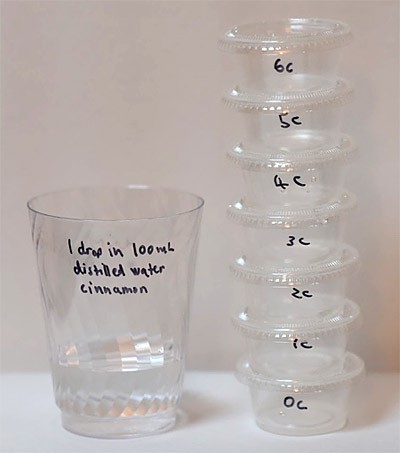 Image Credit: Svenja Lohner, Science Buddies / Science Buddies
Image Credit: Svenja Lohner, Science Buddies / Science Buddies
Figure 3. Prepared dilution series for the cinnamon smell samples.
- Repeat step 8 for each of the other scents. At the end, for each scent you should have six mini cups filled with 5 mL solution (different concentrations in each) and one water control. Table 1 gives you an overview of what dilutions you have made and what the dilution factor is for each smell sample.
- Keep the mini cups closed with a lid until your volunteers are ready for the smell test. Remember that you should do the smell test within 1–2 days of preparing your scent solutions. If it takes longer than that, you should prepare fresh solutions for the test. Write down in your lab notebook when you prepared the scent solutions and when you perform the smell test.
Performing the Smell Test
Ideally, your surrounding should be free of distracting smells while performing the smell experiment. Your volunteers should also be free of colds so they can actually smell the odorant. In addition, they should not wear perfume and should be free of hand lotion or other fragrance cosmetics. Also, try the smell test yourself first, to find out how long the test takes and if you chose the correct concentration range for each scent. Do not include your personal results in your data table.
- Recruit your volunteers for the smell test (8–10 people is a good number, but if you find more, that is even better). Let them know the day and time of your experiment and how long it should take (approximately 1 hour).
- You should do the smell test with one volunteer at a time so that the other volunteers do not hear any responses before it is their turn to smell the odor samples. You can do it in parallel with several volunteers if you make sure that they do not hear each other's responses; for instance, you could have them write their responses on a piece of paper and collect it to put the data in your data table.
- Assign each volunteer an identification number so that your data can be recorded anonymously.
- Copy Table 2 five times (one for each scent) in your lab notebook to record your data from the smell test.
| Scent: | Odor Threshold: | ||||||||||||||||||||
|---|---|---|---|---|---|---|---|---|---|---|---|---|---|---|---|---|---|---|---|---|---|
| Cup Number | 0 | 1 | 2 | 3 | 4 | 5 | 6 | ||||||||||||||
| Volunteer # | Trial # | Trial # | Trial # | Trial # | Trial # | Trial # | Trial # | ||||||||||||||
| 1 | 2 | 3 | 1 | 2 | 3 | 1 | 2 | 3 | 1 | 2 | 3 | 1 | 2 | 3 | 1 | 2 | 3 | 1 | 2 | 3 | |
| 1 | |||||||||||||||||||||
| 2 | |||||||||||||||||||||
| 3 | |||||||||||||||||||||
| 4 | |||||||||||||||||||||
| 5 | |||||||||||||||||||||
| 6 | |||||||||||||||||||||
| 7 | |||||||||||||||||||||
| 8 | |||||||||||||||||||||
| ... | |||||||||||||||||||||
| Response Key: 1 = incorrect guess, 2 = correct guess, 3 = incorrect detection, 4 = correct detection | |||||||||||||||||||||
- Start with your first volunteer and pick your first scent to test. Take your blank mini cup (cup 0 with only distilled water) and the mini cup with the lowest odor concentration (mini cup 1) and hand them both to your volunteer. Note: You will start with the lowest concentration first (mini cup 1) and then continue with cups 2–5 until you get to the highest concentration (mini cup 6). The volunteer will always get a mini cup with scent solution (1–6) and the blank mini cup for comparison (but he or she should not be able to see which one is the blank cup, so you might hide your cups before you hand them to your volunteer or ask them to close their eyes while they smell the solutions. Alternatively, you can hide the numbers somehow, for example by covering them with masking tape.
- Tell your volunteers that you are performing a smell experiment to find out what the lowest amount of a scent is that they can smell. Let them know that all the scents are food-related and that none of the smells is disgusting. Do not give away what specific scent they get. Tell them that one of the cups contains the odorant and the other one does not. The volunteer's task is to find out which of the cups contains the scent. Now tell them to smell into each mini cup. The best way to do this is to have them swirl the cup briefly and carefully, with the lid on, then open the lid and quickly put their nose deep into the cup, just above the liquid surface. Have them take a deep breath and then concentrate on the smell.
- Give the volunteers about 3–5 seconds to smell each cup and then ask which cup contains the odor. If they do not know, they need to guess (they should tell you if they guess or know the answer). Write down your volunteer's response in your data table, using this specific response key: 1 = incorrect guess, 2 = correct guess, 3 = incorrect detection, 4 = correct detection. Note: They do not need to find out what specific scent they smell; they just have to identify the cup that contains the odor.
- Once the volunteer is done smelling the first two cups, take both mini cups back and present the next two cups (next higher concentration (cup 2) and the blank (cup 0) again).
- Repeat step 8 until your volunteer has smelled all the concentrations (cup 1–cup 6). Write down your volunteer's response for each sample.
- After you are done with the first scent, tell the volunteer that you are now starting with a different scent and repeat steps 6–9 with the next scent. Do this until your volunteer has smelled all the cups for your five different scents.
- Once you are done with all five scents, repeat the whole smell test again, two times with the same volunteer. Put all the data for trials 2 and 3 in your data table. This way you will get three data points (trial #1–#3) for each scent and each volunteer, which makes your data more reliable.
- Once one volunteer has finished doing the smell test three times in a row, you can proceed to the next volunteer and repeat the same experiment again. Do this with all your volunteers and record all their responses in your data table.
Analyzing Your Data
- After all your volunteers have finished three trials of smelling all five scents, you can start analyzing your data and determining the odor threshold for each one.
- Pick one scent and perform the following steps on the data table for this scent.
- Look at your data table for this scent. For each individual volunteer, find out all mini cup numbers for which they have identified the cup containing the scent correctly for all three trials. These should be all the cup numbers/dilution levels at which you entered a 4 (= correct detection) for all three trials. Highlight these cells in your data table.
- For determining the odor threshold for this scent, you have to find the cup number/dilution level at which more than half of your volunteers identified the scented sample correctly. You can do that by looking at and comparing all the highlighted cells in your data table. Once you identify the cup number at which more than half of your volunteers identified the scented sample correctly, mark it with a highlighter or permanent marker.
- Now you can can look up the corresponding dilution factor from Table 1. This dilution factor is equal to the odor threshold for this scent. Write it down in your data table.
- Repeat step 2 for each of the scents.
- Make a bar graph presenting the different odor thresholds for each scent. On the x-axis, plot the different scents and on the y-axis, plot your determined odor thresholds.
- Looking at your data table and graph, do you see any trends? Do the odor thresholds differ between scents and are they very different? Is there a specific smell that stands out? If yes, why do you think this is the case (think about where these smells occur in the real world)? What can you learn from your results about your sense of smell? As you do your analysis, remember that higher dilution factors indicate more-diluted or less-concentrated samples.
Ask an Expert
Global Connections
The United Nations Sustainable Development Goals (UNSDGs) are a blueprint to achieve a better and more sustainable future for all.
Variations
- How does the sense of smell vary between your volunteers? Look at your data tables again and for each scent, determine the individual odor threshold for each volunteer (this is the dilution factor at which this person correctly identified the scent (scored a 4) in all three trials for the first time). Then plot the odor thresholds for each individual volunteer in a bar graph for each scent by putting the volunteer number on the x-axis and the odor threshold for each volunteer on the y-axis. Compare the different values, are they very different? Is there one person that stands out and smells much better or worse than the others? Why do you think there is variation between individual volunteers?
- Another important value for odor measurements, besides the odor threshold, is the odor-recognition threshold. Determining the odor threshold means that your volunteers only have to identify which mini cup contains the odorant, but they do not have to recognize the actual scent. This is different for the odor-recognition threshold. It is defined as the concentration at which half of your volunteers can actually recognize which specific odor they smell. To determine the odor-recognition threshold, repeat this experiment, but this time ask your volunteers to tell you for each different odor concentration what they think the scent is (add 5 = incorrect recognition and 6 = correct recognition to your response key). Include this information in your data table and determine the odor-recognition threshold for each smell the same way as you determined the odor threshold. Is it very different from the detection threshold?
- You have only tested 5 of the 21 available scents in this experiment so there are many more smells to explore! Repeat this experiment and choose a different variety of smells. You are not limited to the scents that come with the kit. Think about where else you could find odor samples to use, such as different perfumes. Try the new samples out yourself first, before you invite your volunteers for the smell test.
- Does one's sense of smell change with age? Some research has shown that when you get older, your sense of smell does change. You can find out for yourself by repeating this experiment, but grouping your volunteers according to age. You should find about 8–10 volunteers for each age group to get representative results. Who do you think will be able to identify lower concentrations of different smells—children or adults?
- It is one thing to identify and recognize a certain smell, but what about remembering a specific scent? Many researchers tried to find out how the so-called olfactive memory works. Try to design an experiment that tests how well your volunteers can remember different smells.
Careers
If you like this project, you might enjoy exploring these related careers:






